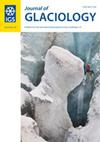Seasonal changes in submarine melting mechanisms controlling frontal ablation of Hansbreen, Svalbard
IF 2.6
3区 地球科学
Q2 GEOGRAPHY, PHYSICAL
引用次数: 0
Abstract
Abstract We describe the annual pattern of frontal ablation driven by submarine melting mechanisms at the Hansbreen terminus: these are reflected in the intensity and spatial distribution of calving events. Analysis of time-lapse images of the Hansbreen front in conjunction with oceanographic and meteorological data shows that calving intensity is driven primarily by seawater temperature. Regression analysis also highlights the importance of air temperature, which we take to be a proxy for surface ablation and subglacial discharge. This, combined with seasonal changes in ice cliff tortuosity and the increasing significance of wave motion outside the ablation season, enabled us to determine seasonal changes in the mechanisms of ice cliff undercutting by submarine melting. While submarine melting controlled by estuarine circulation primarily drives frontal ablation in summer, wave-driven melting at the waterline is more important outside the ablation season. During winter, ice cliff undercutting by melting is suspended by low seawater temperature, negligible subglacial water discharge and sea-ice cover. The most intense frontal ablation, recorded in summer, was related to higher sea temperature and vigorous estuarine circulation.控制斯瓦尔巴群岛汉斯布林锋面消融的海底融化机制的季节变化
我们描述了在汉斯布林末端海底融化机制驱动的锋面消融的年模式:这些模式反映在产冰事件的强度和空间分布上。结合海洋学和气象资料,对汉斯布林锋的延时图像进行分析,表明产犊强度主要是由海水温度驱动的。回归分析还强调了气温的重要性,我们认为气温是地表消融和冰下流量的代表。结合冰崖弯曲度的季节变化和消融季节之外波浪运动的日益重要的意义,使我们能够确定海底融化冰崖破坏机制的季节变化。在夏季,由河口环流控制的海底融化主要驱动锋面消融,而在消融季节之外,波浪驱动的水线融化更为重要。在冬季,由于海水温度较低,冰下水量和海冰覆盖可忽略不计,冰崖的融化被暂停。记录到的最强烈的锋面消融发生在夏季,与较高的海温和旺盛的河口环流有关。
本文章由计算机程序翻译,如有差异,请以英文原文为准。
求助全文
约1分钟内获得全文
求助全文
来源期刊

Journal of Glaciology
地学-地球科学综合
CiteScore
5.80
自引率
14.70%
发文量
101
审稿时长
6 months
期刊介绍:
Journal of Glaciology publishes original scientific articles and letters in any aspect of glaciology- the study of ice. Studies of natural, artificial, and extraterrestrial ice and snow, as well as interactions between ice, snow and the atmospheric, oceanic and subglacial environment are all eligible. They may be based on field work, remote sensing, laboratory investigations, theoretical analysis or numerical modelling, or may report on newly developed glaciological instruments. Subjects covered recently in the Journal have included palaeoclimatology and the chemistry of the atmosphere as revealed in ice cores; theoretical and applied physics and chemistry of ice; the dynamics of glaciers and ice sheets, and changes in their extent and mass under climatic forcing; glacier energy balances at all scales; glacial landforms, and glaciers as geomorphic agents; snow science in all its aspects; ice as a host for surface and subglacial ecosystems; sea ice, icebergs and lake ice; and avalanche dynamics and other glacial hazards to human activity. Studies of permafrost and of ice in the Earth’s atmosphere are also within the domain of the Journal, as are interdisciplinary applications to engineering, biological, and social sciences, and studies in the history of glaciology.
 求助内容:
求助内容: 应助结果提醒方式:
应助结果提醒方式:


